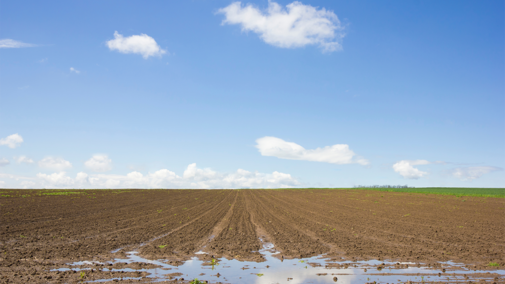I know I should never complain about the rain, but lately wet weather has plagued us and because of it, field work is lagging behind. Rather than complaining, I thought I’d talk a little about how the wet field conditions might affect compaction and how compaction risk might be minimized.
I think farmers are generally aware that when the soil is wet, compaction is a bigger problem, but did you know that as the soil starts to dry out, the compaction risk actually goes up a bit before it decreases? That means that going out just after it’s started to “settle off” might be worse than entering the field when it still has water standing. This is because when the field is saturated, the water keeps the soil pores from completely compressing. You’re still much more likely to compact the soil when the field has water standing in it as compared to when it’s totally dry, but the worst possible time to go back out in the field is just after the water has disappeared.
Related
Optimizing Agricultural Practices: Balancing Manure Use and Minimizing Compaction
You may be thinking, “well, now what? I need to wait even longer?” The short answer is yes, waiting until it’s dry enough is certainly the best option. However, sometimes we have to do things that are less than desirable, so opting to minimize compaction risk is best.
Choose less risky fields: Consider looking at the different fields you have and choose to start fieldwork in the field that is least likely to compact. Think about fields with something already growing — like those with cover crops — as roots will minimize compaction. Also look for fields that have better soil aggregation — like those that have received manure in the past — as aggregation is the ability of the soil to maintain its structure. Indicators of better aggregation when you pick up a clod of soil include larger pore sizes (the holes that allow water to get in), bigger clumps when breaking the clod apart, and the soil holding its form when you put it in water.
If you absolutely have to get in the field in sub-prime conditions, utilize equipment features that minimize compaction. If you have radial tires, use them to your advantage. You paid for that feature after all, so deflate your radial tires to “field pressures” once you get off the road to minimize wheel compaction. And if you’re not willing to deflate your tires some, consider using equipment with tracks instead.
Also, remember that the worst compaction happens on the first pass across the field, so controlling traffic will help minimize compaction as a whole. The one area that receives repeated traffic might be worse, but the for the field average will be better than if equipment is run over many parts of the field.
Remember, compaction (especially sidewall compaction or smearing) decreases root growth, which leads to lower yields and less profit potential, so thinking about these things and being patient may pay dividends. It’s hard to wait, but in the end, it’s worth it. And while you’re waiting, check out the latest webinar on manure and compaction on the Livestock and Poultry Environmental Learning Community website.
This article was reviewed by Aaron Daigh.

